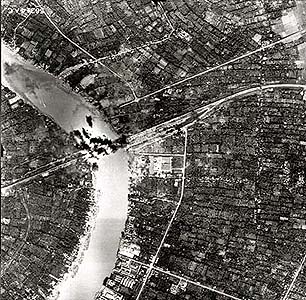Bombing of Bangkok in World War II
| Bombing of Bangkok | ||||||
|---|---|---|---|---|---|---|
| Part of Pacific War | ||||||
 Allies bombed Rama VI Bridge |
||||||
|
||||||
| Belligerents | ||||||
|
|
|
|
||||
Bangkok was bombed by both the Japanese during their invasion of Thailand, and on numerous occasions by the Allies during World War II. It was also the target for the first combat mission by Boeing B-29 Superfortresses in June 1944.
Military targets at and near Bangkok were first attacked by 3rd Air Group's (第三航空隊) Mitsubishi Ki-30s of the 31st Sentai under Lt Col Hayashi Junji as part of the Japanese invasion of Thailand. Prior to the start of the invasion, fighters from the 77th Sentai and bombers of the 31st Sentai moved to Siem Reap close to the Thai border. On the morning of 8 December 1941, they were ordered to attack Aranyaprathet airfield on their way to Bangkok. Nine 31st Sentai bombers, escorted by 11 Nakajima Ki-27s of the 77th Sentai led by Japanese air ace Major Yoshio Hirose (広瀬 吉雄), headed for the Thai capital. On their approach they were intercepted by three Thai Air Force Curtiss Hawk III fighters from 43 Squadron. These were flown by Flight Lieutenant Chin Chiramaneemai, Flight Lieutenant Chai Sunthornsing and Flying Officer Sarit Potivetchagul and were based at Watana Nakorn airfield in Prachinburi Province. They had been advised not to engage the superior aircraft, but they took off anyway as a matter of national pride. Major Hirose, Lieutenant Yoshiro Kuwabara and Lieutenant Tsuguo Kojima shot down all three planes, killing the Thai pilots. This was the only air raid during the Japanese invasion of Thailand, since the Thai government of Field Marshall Pibunsongkhram acceded to Japan's demands by 13:00 that same day, although fighting continued much longer on the ground until the cease fire was announced. On 21 December 1941, Thailand signed an alliance with Japan. On 25 January 1942, the Thai government declared war on the United States and the United Kingdom, although the regent refused to sign it in the name of the young king (who was studying in Switzerland). On December 8, 1941, at dawn, the Japanese forces invaded the eastern part of Thailand. Sentoki fighter aircraft attacked Wattana Nakhon Airfield, damaging the control tower, buildings and the runway. The other point of invasion was Wing 5, Prachuap Khiri Khan Province. Officers, enlisted men and conscripts numbering 120 under the command of Wing Commander Mom Luang Prawas Jumsai withstood the attack with bravery. Over four hundred Japanese soldiers were killed while forty men at Thai side died in the battle and only four suffered casualties. The fighting went on until the Government ordered a cease fire. RTAF (Royal Thai Air Force) personnel assisted the resistance against the Japanese. After World War II, the Thai Air Force sent three C-47s to support the United Nations in Korean War. During World War II Japan ask Thai Air Force joining occupying part of Burma.
...
Wikipedia
